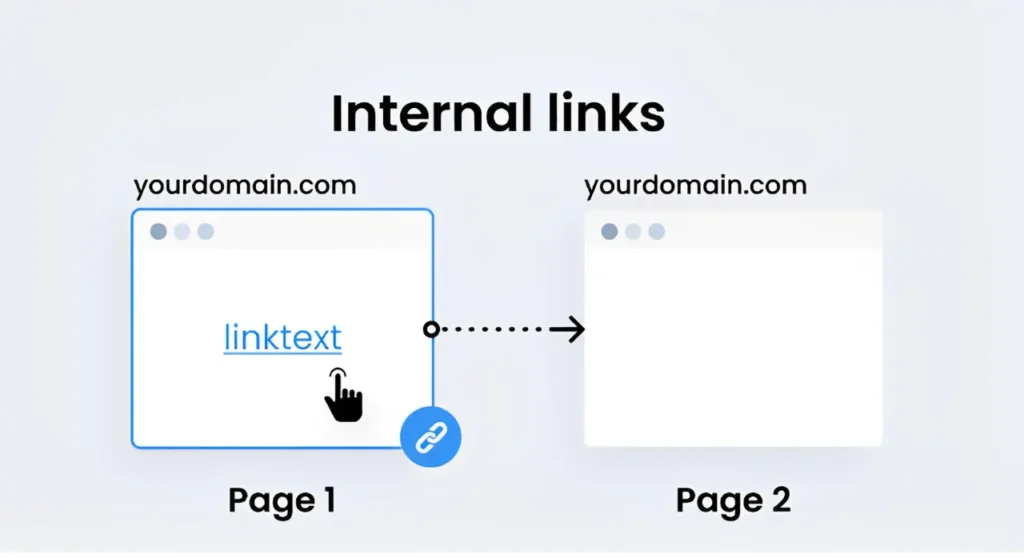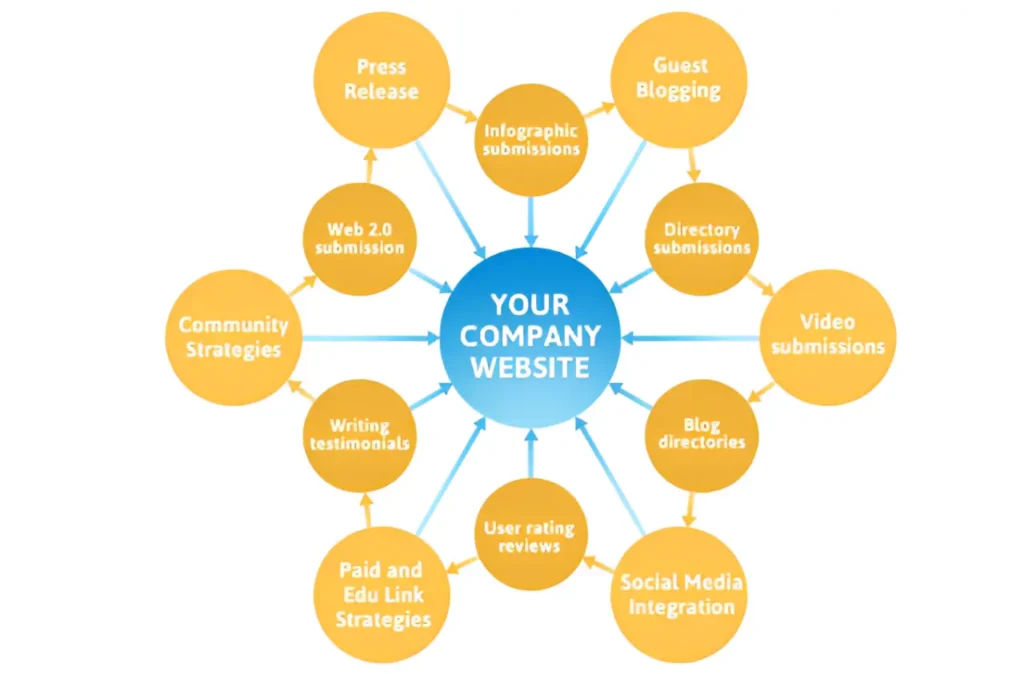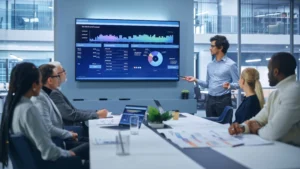Internal linking is commonly associated with search engine optimization (SEO), which refers to linking different pages of a particular website. This strategy also makes browsing your site easier for users and helps search engines understand its structure and content. This article will explain internal linking, why it matters, ways to optimize the process, and how to create a solid internal linking plan.
What is Internal Linking?
Internal linking involves linking one webpage to another on the same site. These links are important for defining a website layout and basic structure. The internal definition further explains that such links help visitors find the content they are interested in while aiding search engine spiders when they index various pages.

Best Practices for Internal Linking
To create an effective internal linking strategy, consider the following best practices:
- Identify Core Pages: Subset the important content of your site—these are major pages important to the audience. The other term for cornerstone is the pillar content. Your site ought to hyperlink these pages frequently.
- Use Descriptive Anchor Text: Internal links should always be labeled with HTML anchor text that provides information about the related web page. This helps the user and the search engine know what to expect when they follow that link.
- Create Contextual Links: These links are found within the body of your content and are considered more useful than navigational links because they offer more information about related content. For example, if you have a page on SEO strategies you will create a link to a page on ‘backlinks in SEO.’
- Monitor Your Links: Inbound link checkers or certain WordPress plugins are regularly used to check the health of internal links. Verifying that all the links are working and do not show a 404 page is imperative to your site’s user experience and SEO health.

How to Implement Internal Linking in WordPress
If you’re using WordPress, here’s how to create internal links:
- How to Create a Hyperlink:
- Select the text that you would like to be converted to a hyperlink.
- To insert a link, place the cursor where you want the link to appear, then click on the link in the editor toolbar.
- Type the Web address of the page you want to turn into a link in the indicated field.
- Using Post Anchors: Anchors can be inserted in a post by making special points in the content that a user would like to navigate to from within the post using links.
- Adding Bullet Points: Bullet points are advisable when listing related topics or resources to improve clarity.
How Internal Linking Affects Google Ranking
Google combines several factors to decide the status of web pages in search engine results. Internal links play a significant role in this process by:
- The web-page networking assists Google in figuring out which page is more important than the others.
- Using Google index guides how their crawlers might find new content when viewing other pages.
- Providing context through anchor text helps define what each linked page is about (contextual meaning).
How Internal Linking Strategies Help with Technical SEO
Technical SEO internals are one of the strategic procedures that meaningfully contribute to site performance and ranking. A correct internal linking plan can enhance site navigation, search engine crawl productivity, and link equity distribution. Since internal linking is an important part of technical SEO, this article discusses how it can help your site.
1: Enhancing Crawlability
In terms of advantages, internal linking can improve the ability to crawl. So when do search engines like Google provide the links and find your site’s content? This means that when internal linking is well established, you give a map to the crawlers where they can find their way around the various pages. This ensures that all conceivable content is discoverable and can rank within the search results.
If your website can be compared to a city, internal links are roads connecting particular districts. If threads (links) point to such areas (pages, in this case), search engines may unearth them. Internal linking guarantees that crawlers can reach your sites, helping them achieve increased visibility in SERP.
2: Distributing Link Equity
Link equity, or “link juice,” is the value passed through the hyperlink between two websites. Internal linking is important in ensuring this link juice is distributed throughout your site. By connecting the high-authority pages to the pages that may require a ranking boost, you can always do so to other pieces that may lack prominence.
For example, if you have a blog post that has received many backlinks, linking it to a less popular or less authoritative one will spread authority. This process helps enhance your website’s health, making it easy for search engines to locate and rank it high.
3: Establishing Content Hierarchy
Using internal links also makes it easy to develop a clear content architecture for your website. Instead, you connect rather large category-oriented pages to specific content, which makes navigation easier for search engines. This clarity helps search engines better understand the relative importance of each of your pages, which will, in turn, help you rank better.
Since the pages are hierarchically connected, the links to the related information can be obtained with further improved experience and interaction with the content. A related layout is a logical hierarchy that benefits users, informing search engines which pages are always the most important for visitors.

Smart Internal Linking for SEO🔗
- keyword-rich anchor text
- Link to high-value pages
- Maintain a clear site structure
4: Improving User Experience
Proper internal linking increases the user experience, as users will find browsing the site easier. If normal users come across relevant links within your content, they are bound to dig deeper into other pages and not just run away as soon as they reach one.
Extended time spent on the site and want-away rate reduced, which produces a sign of approval for search engines as valuable content. By offering ways to generate even more information, you increase the general level of satisfaction among your users and make them come back.
5: Boosting Keyword Optimization
Just like external links, internal links are also used to optimize keywords. Whenever an internal link is placed, descriptive anchor text should provide some background about the website’s contents. This aids the search engine in establishing a relationship between the various pages and increases the possibility of achieving key phrases.
For example, using proper anchor text to connect to a web page named “SEO strategies” when writing “effective SEO strategies” informs search engines about what will be on that page. This makes sense because the strategic use of keywords within internal links yields better visibility in search results.
Conclusion
Internal linking is an effective technical SEO technique that increases a website’s effectiveness. First, optimizing crawlability makes it easier for search engines to spider your site and its data. This helps you achieve better Google rankings and guarantees that users will have access to the needed information. Furthermore, internal linking plays an important role in relaying link juice so that less indexed or visited pages can enjoy the reputation of higher-ranking ones.
Strategically implementing internal links helps determine how most of your content is related to each other and is very helpful for improving usability and informing search engines about how your site is set up. It has also been established that writing descriptive anchor texts for internal links increases the strength of keyword usage, especially when the text briefly describes the linked URLs. It can greatly enhance your probability of ranking for the keywords you want for your content material to rank higher.
FAQs
What is internal linking in SEO?
This is the process of using hypertext links within a particular website to give access to another web page within the same site. It also aids in easy navigation and allows search engines to crawl the site.
How does internal linking improve crawlability?
Internal linking also provides a full topology of links between the pages so that a search engine’s crawler can easily navigate your website. This ensures that all material on the website is searchable and can be trusted to be ranked by search engines.
What is link equity, and how does it relate to internal linking?
Link equity, or link juice, is the value a page receives from a hyperlink to another webpage. Highly authoritative pages pass this equity on to other pages, making them easily visible in search engine results.
Why is content hierarchy important for SEO?
A proper internal linking that divides content across numerous pages provides search engines with information on the relevance of each page on your site. As to the organization, it can help to raise the Google ranking by focusing on certain content.
How can internal linking enhance the user experience?
Internal linking helps the user navigate the website’s content by offering their content to other pages. It encourages scrolling through other pages on your site, resulting in more time and reduced bounce rates.
What role does anchor text play in internal linking?
Keyword usage in the anchor text of internal links gives the user a brief indication of the content to be delivered on the other side when the link is followed. This can enhance keyword optimization and search-related factors such as the number of hits on the company’s websites.
How can I create effective internal links on my website?
Some ways to create internal links include analyzing which content is foundational, using meaningful words and phrases in links, linking to related content naturally within your post, and continually checking your internal links for functionality.
What are some best practices for internal linking in technical SEO?
Some guidelines include using descriptive words when creating anchor text, arranging the web page well, linking from pages with high page rank to pages with related content, and checking for broken links.
How does internal linking affect Google rankings?
Internal linking influences Google results regarding crawlability, link equity distribution, content hierarchy production, and users. All these factors work together or collectively to improve visibility in the hated search engines.
Can internal linking help with backlinks in SEO?
Internal links are different from backlinks, which are links from other websites. However, a quality internal link structure will increase a website’s overall importance, thus increasing the chances that other websites will link to it.








